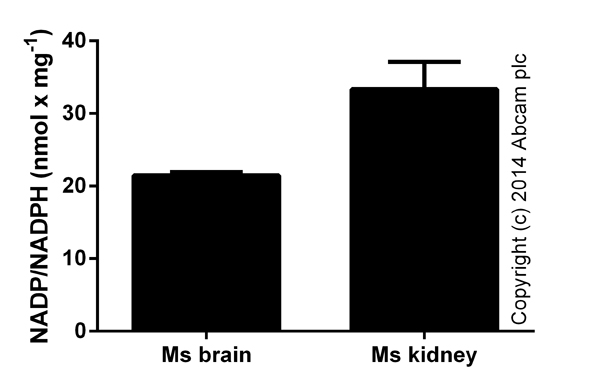Total NADP and NADPH Assay Kit (Colorimetric) (ab186033)
Key features and details
- Assay type: Quantitative
- Detection method: Colorimetric
- Platform: Microplate reader
- Assay time: 2 hr
- Sample type: Cell culture supernatant, Cell Lysate, Tissue Lysate
- Sensitivity: 0.03 µM
Overview
-
Product name
Total NADP and NADPH Assay Kit (Colorimetric)
See all NADP/NADPH kits -
Detection method
Colorimetric -
Sample type
Cell culture supernatant, Cell Lysate, Tissue Lysate -
Assay type
Quantitative -
Sensitivity
> 0.03 µM -
Range
0.031 µM - 1 µM -
Assay time
2h 00m -
Product overview
Nicotinamide adenine dinucleotide (NAD+) and nicotinamide adenine dinucleotide phosphate (NADP+) are two important cofactors found in cells. NADH is the reduced form of NAD+. NAD forms NADP with the addition of a phosphate group to the 2' position of the adenyl nucleotide through an ester linkage. The traditional NAD/NADH and NADP/NADPH assays are based on monitoring the changes in NADH or NADPH absorption at 340 nm. The short UV wavelength of NAD/NADH and NADP/NADPH assays makes the traditional methods suffer low sensitivity and high interference.
Abcam’s Colorimetric total NADP/NADPH Assay Kit (ab136033) provides a convenient method for detecting total NADP and NADPH. The enzymes in the system specifically recognize NADP/NADPH in an enzyme cycling reaction. There is no need to purify NADP/NADPH from the sample mix. The enzyme cycling reaction significantly increases detection sensitivity. The NADPH probe is a chromogenic sensor that has its maximum absorbance at 460 nm upon NADH reduction. The absorbance maximum increases to ~ 635 nm if the enhancer is added to the assay system. The absorption of the NADPH probe is directly proportional to the concentration of NADPH in the solution. The Colorimetric total NADP and NADPH Assay Kit provides a sensitive assay to detect as little as 0.03 µM total NADP/NADPH in a 100 µL assay volume.
-
Notes
Abcam has not and does not intend to apply for the REACH Authorisation of customers’ uses of products that contain European Authorisation list (Annex XIV) substances.
It is the responsibility of our customers to check the necessity of application of REACH Authorisation, and any other relevant authorisations, for their intended uses. -
Platform
Microplate reader
Properties
-
Storage instructions
Store at -20°C. Please refer to protocols. -
Components 400 tests Lysis Buffer 1 x 10ml NADP/NADPH Recycling Enzyme Mixture 2 vials NADPH Probe 1 x 4ml NADPH Probe Buffer 1 x 16ml NADPH Standard 1 x 167µg -
Research areas
-
Relevance
NADP (Nicotinamide adenine dinucleotide phosphate) is a coenzyme composed of ribosylnicotinamide 5-phosphate (NMN) coupled by pyrophosphate linkage to the 5-phosphate adenosine 2,5-biphosphate. It serves as an electron carrier in a number of reactions, being alternately oxidised (NADP+) and reduced (NADPH). The oxidative phase of the pentose phosphate pathway is the major source of NADPH in cells, producing approxiamtely 60% of the NADPH required. NADPH provides the reducing equivalents for biosynthetic reactions and the oxidation-reduction involved in protecting against the toxicity of ROS, allowing the regeneration of GSH. NADPH is also used for anabolic pathways, such as lipid synthesis, cholesterol synthesis and fatty acid chain elongation.
Images
-
NADP/NADPH measured in mouse tissue lysates (5-50 mg/mL tested, expressed as quantity per mg of extracted protein; duplicates +/- SD).
-
NADP/NADPH measured cell lysates, where 5e6 cells were lysed in 0.25 mL. RAW samples were diluted 1/25-1/125 times, Jurkat samples were below level of detection (duplicates +/- SD).
-
NADP/NADPH measured in undiluted human biological fluids (duplicates +/- SD).
-
Standard curve with background signal subtracted (duplicates; +/- SD).
-
NADPH dose response was measured with the Colorimetric Total NADP/NADPH Assay Kit in a 96-well white/clear bottom plate using a microplate reader. As low as 0.03 µM of NADPH can be detected with 1 hour incubation (n=3) with absorbance measurement at 460nm.
The absorbance in blank wells (with the PBS buffer only) is used as a control, and is subtracted from the values for those wells with the NADPH reactions.














